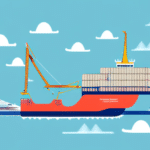What Is a FOB Destination?
In international trade, understanding shipping terms and agreements is essential for both buyers and sellers to ensure smooth and successful transactions. One such critical term is FOB Destination, an Incoterm that defines the transfer of responsibility and ownership of goods during shipping.
Understanding the Basics of FOB Incoterms
Incoterms (International Commercial Terms) are a standardized set of three-letter codes published by the International Chamber of Commerce (ICC) that define the responsibilities of buyers and sellers in international trade transactions. They cover aspects such as the delivery of goods, payment of taxes, and customs duties.
FOB stands for Free on Board, an Incoterm that specifies when and where the transfer of risk and title of goods occurs between the buyer and seller. Understanding FOB Destination requires a grasp of these foundational Incoterms principles.
For a comprehensive overview of Incoterms, refer to the official ICC publication: ICC Incoterms.
Key Features of FOB Destination Shipping Terms
- Risk Transfer: The seller retains responsibility for the goods until they reach the buyer’s specified destination.
- Cost Responsibility: The seller covers all costs associated with transporting the goods to the destination, including freight charges, export fees, and customs duties.
- Insurance: Typically, the seller arranges insurance until the goods arrive at the destination.
These features distinguish FOB Destination from other Incoterms, placing more responsibility and control on the seller until the goods are delivered.
How FOB Destination Differs From Other Incoterms
FOB Shipping Point
With FOB Shipping Point, the transfer of risk and responsibility occurs as soon as the goods are loaded onto the carrier at the seller's premises. This contrasts with FOB Destination, where the transfer happens only upon delivery.
CIF (Cost, Insurance, and Freight)
CIF requires the seller to cover the cost, insurance, and freight necessary to bring the goods to the destination port. Unlike FOB Destination, CIF includes insurance, providing additional security to the buyer.
DAP (Delivered at Place)
DAP shifts more responsibility to the seller compared to FOB Destination. The seller is responsible for delivering the goods to a specified place in the buyer's country, covering all risks and costs except for unloading.
Advantages and Disadvantages of FOB Destination Shipping
Advantages
- Reduced Risk for Buyers: Buyers are protected from risks during transit, as the seller remains responsible until delivery.
- Seller Control: Sellers maintain control over the shipment process, ensuring compliance with shipping standards.
- Cost Transparency: Sellers handle all transportation costs, simplifying the buyer's budgeting process.
Disadvantages
- Higher Costs for Sellers: Sellers bear all transportation costs, which may increase their overall expenses.
- Potential Delays: Any delays in transit are the seller's responsibility, which could impact delivery schedules.
- Less Buyer Control: Buyers have limited control over the shipping process until goods are delivered.
Understanding these pros and cons helps both parties make informed decisions based on their specific needs and risk tolerance.
How to Choose Between FOB Destination and Other Incoterms
Selecting the appropriate Incoterm depends on various factors, including the nature of the goods, destination country regulations, and the level of control and risk each party is willing to assume.
Factors to Consider
- Control over Shipping: Buyers who desire more control over the shipping process might prefer terms like FOB Shipping Point.
- Risk Management: If minimizing risk during transit is a priority, FOB Destination or CIF may be more suitable.
- Cost Implications: Evaluate who will bear the transportation and insurance costs and how that impacts pricing.
For detailed guidance on selecting Incoterms, refer to resources such as the U.S. Department of Commerce Export Assistance.
Common Misconceptions About FOB Destination
Misconception 1: FOB Destination Only Applies to International Shipments
While commonly used in international trade, FOB Destination can also apply to domestic shipments. It simply means the seller is responsible for the goods until they reach the specified destination, regardless of borders.
Misconception 2: FOB Destination Always Places More Burden on the Seller
In reality, the distribution of responsibilities can vary based on the specific agreement between buyer and seller. While the seller generally bears more responsibility under FOB Destination, clear contracts can balance this out.
Misconception 3: FOB Destination Includes Insurance by Default
Insurance coverage depends on the terms negotiated between the parties. It's essential to explicitly state insurance responsibilities in the contract to avoid misunderstandings.
The Role of FOB Destination in International Trade
FOB Destination plays a pivotal role in international trade by clearly defining the point at which responsibility and risk transfer from seller to buyer. This clarity helps prevent disputes and facilitates smoother transactions.
Promoting Fair Trade Practices
By delineating responsibilities, FOB Destination promotes fairness, ensuring that neither party bears undue risk or costs.
Reducing Disputes
Clear terms regarding the transfer of risk and responsibility minimize the potential for conflicts, fostering stronger business relationships.
For more insights on Incoterms and their application in international trade, consult the ICC's official Incoterms 2020 guide.
Examples of FOB Destination Shipping in Real-Life Scenarios
Electronics Industry
A technology company shipping high-value electronics may use FOB Destination to ensure that the seller handles all aspects of shipping, minimizing the buyer's risk of damage or loss during transit.
Agricultural Products
An importer of fresh produce might opt for FOB Destination to have the seller manage the logistics, ensuring timely delivery to preserve product quality.
Automotive Manufacturing
Car manufacturers ordering parts from overseas suppliers often use FOB Destination to guarantee that components arrive in good condition, with the seller responsible for transportation until delivery.
Tips for Successful FOB Destination Shipping Operations
1. Detailed Contracts
Ensure that all terms, including the exact point of delivery and responsibilities at each stage, are clearly outlined in the contract.
2. Choose Reliable Partners
Select trustworthy carriers and insurance providers to mitigate risks associated with transportation and ensure timely delivery.
3. Accurate Documentation
Maintain precise and complete documentation, such as bills of lading, commercial invoices, and packing lists, to facilitate customs clearance and prevent delays.
4. Utilize Expertise
Engage with knowledgeable freight forwarders or customs brokers to navigate the complexities of international shipping and ensure compliance with all regulations.
5. Monitor Shipments
Implement tracking systems to monitor the progress of shipments, allowing for proactive management of any issues that may arise during transit.
6. Insurance Coverage
Consider additional insurance coverage to protect against unforeseen events, providing an extra layer of security for high-value or fragile goods.
Conclusion
FOB Destination is a widely used Incoterm that plays a crucial role in defining the responsibilities and risks in international trade transactions. By understanding its key features, advantages, and potential drawbacks, both buyers and sellers can make informed decisions that align with their business needs and risk management strategies.
Proper implementation of FOB Destination terms, coupled with detailed contracts and reliable shipping partners, can lead to successful and dispute-free transactions.




















